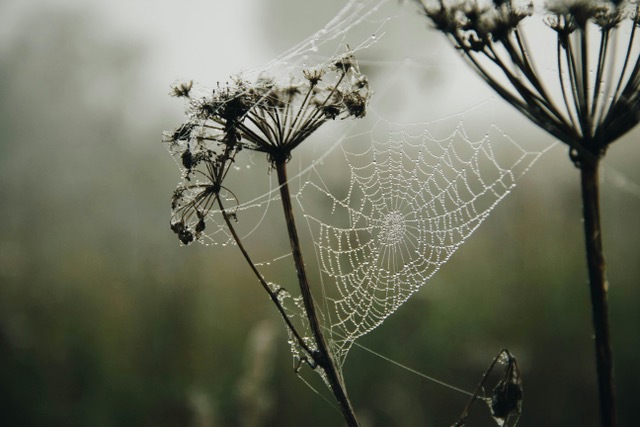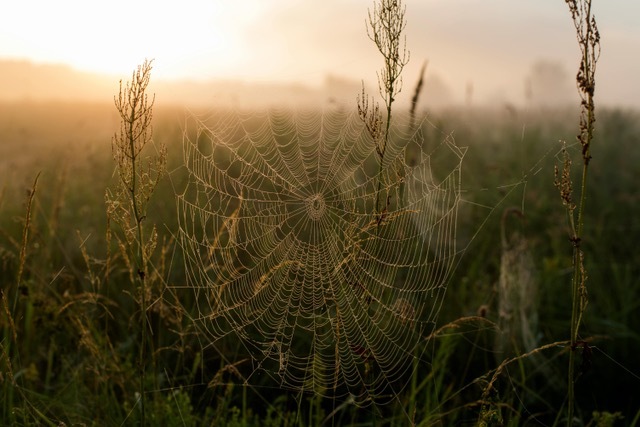The Remarkable Art of Spiderwebs
The Art and Science of Spiderwebs: Nature's Masterpieces
There's something special about foggy, frosty mornings. Some people hate them, but as an artist in New Zealand, I really like them a lot. The air of mystery and suspense hidden in the swirling mist is an inspiration for blending colours and softening effects on the environment.
But most of all, I love how the tiny droplets of water bring out the hidden magic of things like spiderwebs. Love them or hate them, spiders create such beautiful works of art that a fine layer of mist enhances them, making them much easier to see and infinitely more attractive.
The patterns and delicacy of the finely woven structures can be pretty impressive if you take the time to look at them closely.
Nature's Delicate Craftsmanship
When a spider crafts its web, it uses its own body as a measure, showcasing the ultimate in practicality and ergonomic design. This precision and skill make it easier for the spider to navigate the web swiftly and efficiently, ensuring it won't fall through the holes.
Did you know that many of our architectural designs have been inspired by spider webs due to their clever construction and robust design?
Spider webs come in a variety of shapes, not just the common spiral or orb-like ones. Some spiders create funnel, sheet, or tangle webs, each serving a unique purpose and showcasing a different aspect of spider engineering. This diversity is a testament to the ingenuity of nature.
The Process of Web Creation
So, where does the spider start with its design? The first thread is the most daunting for the spider. It uses the wind to carry that first thread from one of its spinnerets to a suitable surface.
This explains why sometimes a spider places its web in a particular spot rather than another. Once the first thread sticks, the spider strengthens it with a second thread, repeating the process until the "first" thread is strong enough to support the rest of the web.
After this stage, the spider creates a "Y" shape configuration. From there, the first three radial surrounds are built. Using its sense of ergonomics, the spider ensures that the space between each radial is small enough for it to traverse. Interestingly, you can estimate the size of a spider without seeing it by judging from the size of its web and the number of radials it has. Handy to know, huh?
Once the radials are finished, the spider strengthens the centre of the web with approximately six circular threads. Then, it creates a non-stick spiral, allowing the spider to move around while building the rest of the structure.
Starting from the outside and working toward the middle, the spider creates the sticky spiral threads that help catch its dinner. As these sticky spirals are produced, the spider removes some of the original non-stick ones as they are no longer needed.
The web is a remarkably efficient way for a spider to gather food. It doesn't need to chase after its prey – it simply waits for it to land on the web. This efficient design is a testament to the ingenuity of nature.

How Spiders Avoid Getting Stuck
So, how do spiders avoid getting stuck in their own webs? The spider chooses a spot in the web spun from non-sticky silk to wait for its prey. When they have to leave their monitoring position to wrap their prey, they carefully navigate only the non-sticky threads, which they know the location of.
Otherwise, it's a pretty high risk, as they can become a target for other insects if they get stuck in their own trap.
As much as I dislike spiders, I admire their webs' true craftsmanship and beauty. Fun fact: Some spider silk is more robust than steel of the same thickness, showcasing not only beauty but incredible strength.
The Art of Spiderwebs
Spiderwebs are a testament to nature's artistry, showcasing intricate designs that rival the most delicate human-made creations.
These natural masterpieces are not only functional structures but also beautiful works of art that can inspire and captivate those who take the time to appreciate their complexity.
Nature's Delicate Craftsmanship
The process of web-making is an impressive display of precision and skill. Each thread is meticulously placed to form a cohesive and sturdy structure capable of withstanding environmental challenges while effectively trapping prey.
The radial and spiral patterns commonly seen in orb webs are a perfect blend of geometry, perspective and aesthetics, with each line contributing to both the web's functionality and visual appeal.
Artistic Inspiration
Artists throughout history have drawn inspiration from spiderwebs. The web's delicate lines and symmetrical patterns are often replicated in various art forms, from paintings and drawings to jewellery and textiles.
The way light interacts with a web, especially when adorned with morning dew or frost, creates a mesmerising spectacle that can inspire new colour palettes and textures in artistic works.
Symbolism in Art
Spiderwebs also carry rich symbolic meanings in art and literature. They are often associated with themes of connectivity, resilience, and the delicate balance of life. The web's ability to capture and hold prey with such efficiency symbolises strength and cunning, while its intricate beauty represents the complexity and fragility of existence.
Practical Applications in Art
Beyond inspiration, the properties of spider silk have practical applications in art. The strength and flexibility of spider silk have been studied for use in creating durable and lightweight materials. Artists and designers are exploring ways to incorporate these properties into their work, creating pieces that are both beautiful and resilient.
Capturing the Essence of Spiderwebs
Photographers, in particular, find spiderwebs to be a fascinating subject. Capturing the intricate details of a web requires skill and patience, often resulting in stunning macro photographs that reveal the minute complexities of each thread. These images highlight spiderwebs' beauty and invite viewers to see the natural world from a new perspective.
Integrating Webs into Installations
Some contemporary artists go a step further by incorporating actual spiderwebs into their installations. By providing a controlled environment for spiders to spin their webs, these artists can create unique and organic art pieces that blur the line between nature and human creativity.
These installations often provoke thought about the relationship between humans and the natural world, emphasising the delicate interplay of life and art.
With their blend of functionality and beauty, Spiderwebs offer endless inspiration and opportunities for artistic expression. Whether through direct representation or as a muse for creative exploration, the intricate artistry of spiderwebs continues to influence and enrich the world of art.

FAQ about Spiderwebs
Q: How do spiders create their webs?
A: Spiders start by using the wind to carry a thread from one of their spinnerets to a suitable surface. Once it sticks, they strengthen this initial thread with more silk until it's strong enough to support the rest of the web. They then build a "Y" shape configuration and add radial threads, followed by non-sticky spiral threads for structure, and finally, sticky spiral threads to catch prey.
Q: Why don't spiders get stuck in their own webs?
A: Spiders have special non-sticky threads that they use to move around the web. They also have a specific waiting spot made from non-sticky silk. When moving to capture prey, they carefully navigate only the non-sticky parts of the web.
Q: Are all spider webs the same?
A: No, spider webs come in various forms. While the spiral or orb-shaped webs are the most common, there are also funnel webs, sheet webs, and tangle webs. Each type serves a different purpose and is constructed differently.
Q: What materials do spiders use to make their webs?
A: Spiders use silk produced from their spinnerets. This silk is made of proteins and can vary in strength and elasticity depending on its purpose, such as structural support or sticky traps for catching prey.
Q: How strong is spider silk?
A: Spider silk is actually incredibly strong. Some types of spider silk is said to be stronger than steel of the same thickness, showcasing not only beauty but also remarkable strength and resilience.
Q: How do spiders know where to place their webs?
A: Spiders often rely on environmental cues and the availability of prey to decide where to place their webs. The initial placement of the first thread is often guided by the wind, which helps the spider find a suitable location.
Q: Do spiders reuse their webs?
A: Many spiders will consume their old webs to recycle the silk proteins and use them to build new webs. This efficient recycling helps conserve the energy required to produce new silk.
Q: What is the purpose of the different types of silk threads in a spider's web?
A: Different silk threads serve various purposes. Non-sticky threads provide structure and allow the spider to move around without getting stuck. Sticky threads are designed to trap prey. Some threads are also used to wrap and secure prey once it's caught.
Q: How do environmental conditions affect spider webs?
A: Environmental conditions like humidity and temperature can affect the properties of spider silk. For example, webs can become more visible in foggy or dewy conditions as tiny water droplets cling to the silk threads, highlighting their intricate patterns.
Q: Can studying spider webs help in human technology?
A: Absolutely. Spider webs have inspired various fields, including architecture and materials science not just art. Their strength, flexibility, and intricate design offer insights into creating more efficient and resilient structures and materials.
Spiderwebs are not just a marvel of nature but a source of endless inspiration and knowledge. Their blend of functionality, beauty, and strength continues to captivate and influence both scientists and artists alike. Whether viewed through a scientific lens or an artistic one, spiderwebs remain one of nature's most exquisite creations.
The Spider; Pet Portrait
Conclusion
Spiderwebs are a marvel of nature, showcasing a perfect blend of beauty, functionality, and strength. These intricate structures, spun with extreme care by their arachnid architects, serve as both practical tools for survival and stunning works of art.
Their delicate patterns glistening in the morning dew or their impressive engineering and material properties are not just for aesthetic appreciation, but also a testament to nature's ingenuity and adaptability.
The artistry of spiderwebs has inspired countless human creations, from architectural designs to artistic endeavours, highlighting the deep connection between nature and human creativity.
As we continue to explore and appreciate these natural masterpieces, we gain a greater understanding and respect held for the intricate and delicate balance of life that they represent, a balance that is both awe-inspiring and humbling.
Spiderwebs remind us of the beauty and ingenuity found in even the smallest corners of our world. By taking the time to observe and learn from these remarkable structures, we not only enrich our appreciation for nature but also find inspiration for our own creations.
So, the next time you encounter a spiderweb shimmering in the mist, take a moment to marvel at its intricate design and reflect on the extraordinary artistry woven into the fabric of our natural world. Share your experiences with spiderwebs and let's celebrate the beauty of nature together.

